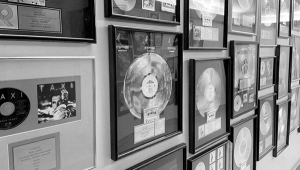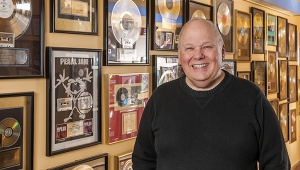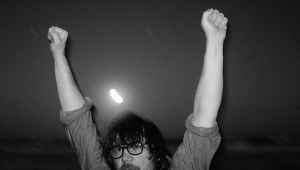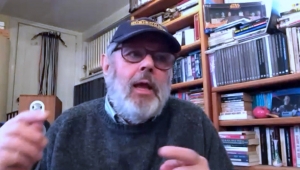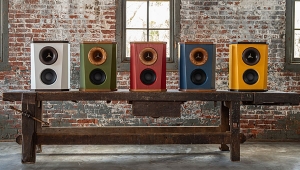| Columns Retired Columns & Blogs |
Home-Grown: Michael Kelly of Aerial Acoustics Page 2
Phillips: You custom-finish all of the drivers?
Kelly: They are all custom, yes, and some of them we finish. The midrange is half manufactured by us. I think that drivers should be uniform to begin with—very close to the design reference—only then should you come along and pair-match them.
Once you have a speaker that is wide-band, linear, and natural, slight changes in drivers or network components are extremely audible. Secondary things then become primary things. We hand-finish the midrange in order to assure unit-to-unit variation that is vanishingly small.
The tweeter is new—introduced within the last year. It's a two-chamber design made in Germany, and it has a very large, egg-shaped secondary chamber designed to have very little acoustic signature. Its vent is flared at both ends. There are five additional vents through the steel in the back plate, and it has the largest surround on any tweeter I know of—which damps the titanium dome. It doesn't have the usual metallic quality you get with most domes. It sounds like music, not a tweeter.
The midrange is a twin-cone Kevlar design, made for us by Focal. A layer of aerated epoxy is injected between the two cones, which works like an I-beam. If the cone starts to flex, the inner skin or the outer skin has to stretch in order for that epoxy to bend. One of the most attractive properties of Kevlar is that it won't stretch—it'll bend and flex, but it won't stretch. We get a very dead cone that way.
The woofer is in its second generation too. Vifa assembles it for us in their large production facility. We could do it ourselves, but we're so small it would cost a lot more. Vifa has come up with a basket superior to our original—mechanically more rigid and not even particularly expensive. We've also enlarged the magnet system. The cones are made out of a fibrous coated material, and there's a solid moat of epoxy under the dustcap—which rigidifies the cone-neck area, making for a mechanically and acoustically sound driver.
We mount the woofer high on the cabinet in order to place it near the midrange acoustically—and also so that the floor-reflection notch would be pretty close to the crossover frequency. It becomes part of the crossover design.
Phillips: Tell us about the crossover.
Kelly: Dave did a lot of the crossover—it's a 24dB/octave, true acoustic Linkwitz-Riley network. We chose it for several simple reasons. First of all, we wanted all the drivers in-phase. If you start there, your only choices are 6dB or 24dB. At 6dB, you end up with audible output from the drivers several octaves above and below the crossover frequencies. This is a problem, because most drivers are only adequate for two to three octaves. A lot of 6dB/octave crossovers are only 6dB for a couple of octaves, and then turn into a much more rapid slope.
We want to only use the centers of the bandpasses of the drivers and then rely on the networks to have repeatable, very controlled rolloffs that are not a function of phase problems or interference from the drivers themselves. It's a purist approach, and sonically we feel it's the best.
You can always hear filters, so we don't use them to smooth out irregularities. We use linear drivers, utilize the center of their bandpasses, and we roll them off very precisely with the electrical components of the network—and we only use the finest components to do that.
We use OFC copper throughout, and we use metallized polypropylene—except in some of the very large capacitors in the bass circuit, which are in shunt positions. We use a nickel/steel-core coil in the bass circuit, which only saturates above 1000W and has a very closed hysteresis loop—giving it virtually no footprint on the time axis. That one reason the bass is so nice and tight.
If you call resistors elements, we have 27 elements in the crossover. We did a lot of listening before we settled on this design.
Phillips: I imagine there are people wondering why they've never heard of Aerial. Was growing the company slowly a deliberate decision?
Kelly: Absolutely! One reason I started Aerial was that I had my own ideas about how a company should relate to its customers and what it should offer in the way of real substance. I'd worked for some very large, fairly successful companies, but I longed to do things the way I would want to be treated.
And early on—please don't take offense at this—I decided that I didn't want to risk the fate of the company on a magazine review. Obviously, a bad review can kill a small company like us, but a rave review has its own dangers—it can force you to try to expand far too rapidly. We'd put so much into the company that it just didn't make sense to gamble it that way. We made the product we wanted to make, and then we built up a dealer network that was small but first-rate. We have great dealers!
We built the company without acquiring any outside debt. We pay our vendors within 10 days, whether or not they require it. We even make a little profit. So we've become stable and we're here for the long haul. We have a fantastic staff. We've been lucky that way, and its one of our great strengths. We're really a strong little company. Strong enough to say, "Now it's time for Stereophile to take a look at us."
- Log in or register to post comments

